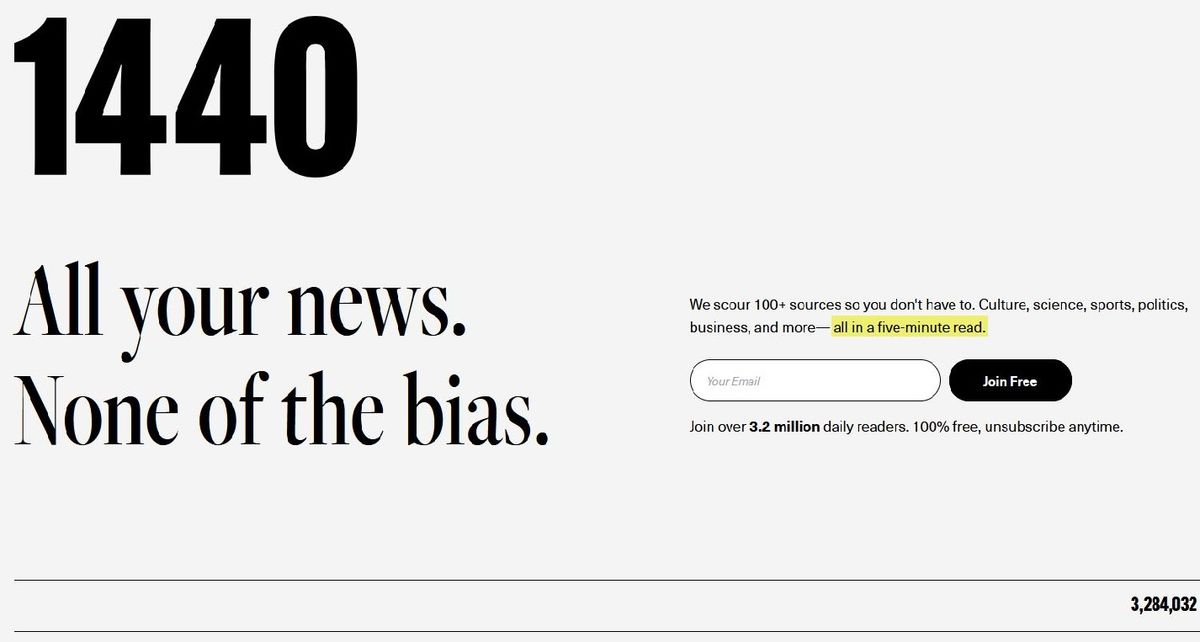"All your news. None of the bias."
That's the pitch for the media company 1440's daily newsletter, which now has over 3.2 million subscribers. The enterprise began in 2017 as a collaboration between a scientist (Andrew Steigerwald) and a businessman (Tim Huelskamp, not to be confused with the congressman of the same name).
"I used to spend the first 90 minutes of my day reading newsletters and articles just trying to understand what happened yesterday," Steigerwald, who is now 1440's editor-in-chief, told Snopes in a Zoom interview.
But that was a lot of work. So the pair made it their full time job, creating 1440's newsletter to save other people the time.
But just because a publication advertises itself as unbiased doesn't mean it actually is, and Snopes readers asked us to evaluate 1440 as a company and as a news source. So, we did.
Steigerwald said that 1440 makes over 95% of its income off of advertisements, with a small proportion coming from reader donations. He also explained that the company reviews potential advertisements before a newsletter with those ads are sent out. 1440 is largely employee-owned, with the remaining holdings from a venture capital firm.
There were no major discrepancies in how Steigerwald described the editing practices in the newsroom: Blurbs for the newsletter are edited and fact-checked before being published, and the final newsletter reflects that. 1440 does not feature any opinion columns and keeps its news event summaries very brief. Each event comes with a small blurb of text, generally between one sentence and one paragraph, explaining the basic details of whatever is going on.
"We try to go an inch deep and a mile wide," Steigerwald said.
If a reader would like to learn more about a certain topic, each event in the newsletter features one or multiple links to longer articles about the topic from high-quality independent sources like The Associated Press. Steigerwald explained that 1440's editorial team looks at dozens of these articles on a topic before making a subjective assessment on which links to direct readers to in the newsletter.
The use of the word subjective brings up an interesting point, however, because it is the exact opposite of the general public's expectation for journalists to be unbiased and objective.
But organizations that classify media bias, like Ad Fontes's Media Bias Chart, don't use the word "unbiased." The chart, which places 1440 right in the center of the political bias spectrum, calls the category "middle or balanced bias" instead.
There's a pretty simple explanation for why a media bias chart doesn't use the word unbiased: Many journalists don't believe it's truly possible to be unbiased because they are human. This is a contentious and ongoing debate in the industry, and has been for a long time, so a brief summary like the one we've provided below is not even close to comprehensive, and should be thought of as a starting point for further research.
Traditionally, it is the moral responsibility of a journalist to present information in an objective and unbiased manner — in other words, looking only at verified facts and setting aside personal biases. One could connect that principle to the so-called "fourth estate," a phrase that implies that the press is just as important as the traditional three estates (nobles, clergy, commoners, respectively) in influencing public policy.
But as long as journalism has existed, there have been attempts to distort the truth. In the 1890s, newspaper magnates Joseph Pulitzer (of Pulitzer Prize fame) and William Randolph Hearst (the inspiration for "Citizen Kane") began a "war" of sensationalism against each other. The style of reporting they published became known as yellow journalism, and can be considered an ancestor of modern "clickbait." It also helped to start an actual war. The sensationalist style of yellow journalism faded in the early 1900s, because as it turns out, you can only exaggerate so much before people just stop believing anything you write.
And so, objectivity reigned supreme.
Until the 1960s, that is, when postmodernist philosophers began to question everything they thought they knew about the world. For the purposes of this article, you need to know exactly two things about postmodernism: a) postmodern thought became very popular in academia and b) postmodernists do not believe in the concept of one "objective natural reality."
For young, aspiring journalists in college taught using postmodern frameworks, a paradox quickly arose: How in the world can you claim to be objective and unbiased if you don't believe that people can be objective and unbiased in the first place?
The most common answer is to do a lot of soul-searching. Instead of having a moral responsibility to be objective and unbiased, journalists instead must understand their biases and how they affect reporting. Ruben Salvadori's project "Photojournalism behind the scenes" is a great exploration of this concept. For an example a bit closer to home, Snopes' editorial standards insist that our writers recuse themselves from writing on topics they do not think they can cover fairly.
The problem remains though: If you don't believe that unbiased reporting can exist, then it's impossible to agree with the claim that 1440's newsletter is "unbiased" in any capacity. But, regardless of personal opinions about "unbiased-ness," both Snopes' investigation and the Ad Fontes Media Bias Chart found that 1440's newsletter generally sticks to the facts and does not favor one political leaning over another.
